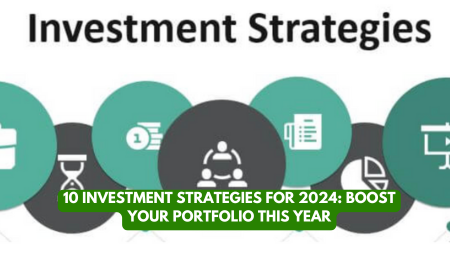No products in the cart.
Stock Market
10 Investment Strategies for 2024: Boost Your Portfolio This Year
Investment Strategies for 2024: Boost Your Portfolio This Year

Investors must modify their strategy in response to changing market conditions in order to take advantage of new trends and opportunities. Having a well-thought-out investment strategy can help you handle market volatility and reach your financial goals, regardless of your experience level. This article covers ten investment options for 2024 that will help you increase your portfolio and optimize returns.
Top 10 Investment Strategies for 2024
1. Embrace Technological Innovation
Technology continues to foster innovation and disrupt traditional economic sectors. The rapid advancement of artificial intelligence, blockchain technology, and renewable energy solutions presents significant investment opportunities with substantial growth potential in the coming years.
Key Technology Sectors to Watch
- Artificial Intelligence (AI): Companies developing machine learning algorithms, natural language processing, and automation technologies
- Blockchain and Digital Assets: Beyond cryptocurrencies, blockchain applications in supply chain, healthcare, and finance
- Renewable Energy: Solar, wind, and alternative energy storage solutions
- Biotechnology: Gene editing, personalized medicine, and healthcare technology innovations
Implementation Strategy
Consider allocating a portion of your portfolio to technology-focused ETFs, established tech companies with strong innovation pipelines, or carefully selected growth-oriented startups with proven business models.
2. Prioritize ESG Investing
Environmental, social, and governance (ESG) considerations are becoming increasingly important for investors who want to align their investments with their values. Companies demonstrating strong ESG principles often exhibit better risk management and long-term sustainability.
ESG Investment Approaches
- Environmental Factors: Climate change initiatives, carbon footprint reduction, water conservation
- Social Considerations: Labor practices, community relations, diversity and inclusion
- Governance Standards: Board structure, executive compensation, corporate ethics
Implementation Strategy
Research ESG-focused mutual funds, ETFs, or individual companies with strong sustainability ratings. Look for transparent ESG metrics and reporting to avoid “greenwashing” – companies that merely claim ESG benefits without substantial practices.
3. Diversify Across Asset Classes
Diversification remains a fundamental principle for managing risk and generating consistent returns. A well-balanced portfolio can help protect against market volatility while capturing growth opportunities across different economic environments.
Asset Class Allocation Considerations
- Equities: Domestic and international stocks across various market capitalizations
- Fixed Income: Government and corporate bonds with varying maturities
- Real Estate: REITs, real estate funds, or direct property investments
- Alternative Investments: Commodities, private equity, hedge funds, or collectibles
Implementation Strategy
Determine an appropriate asset allocation based on your risk tolerance, time horizon, and financial goals. Regularly rebalance your portfolio to maintain your target allocation as market values fluctuate.
4. Invest in Emerging Markets
Emerging markets offer attractive growth prospects thanks to increasing consumer spending, urbanization trends, and favorable demographics. Though these markets may carry additional risk, they can provide significant diversification benefits and potential returns.
Promising Emerging Market Regions
- Southeast Asia: Indonesia, Vietnam, Philippines
- Latin America: Brazil, Mexico, Colombia
- Eastern Europe: Poland, Romania, Czech Republic
- Africa: Nigeria, Kenya, South Africa
Implementation Strategy
Consider allocating 10-20% of your equity portfolio to emerging market stocks and bonds through dedicated funds or ETFs. Research country-specific risks and economic indicators before investing in individual countries or regions.
5. Adopt a Long-Term Perspective
By embracing a long-term investment approach, you can capitalize on the power of compound interest and withstand market fluctuations. Short-term trading often leads to higher costs and taxes while missing out on long-term growth opportunities.
Benefits of Long-Term Investing
- Compounding Returns: The exponential growth of investments over time
- Reduced Transaction Costs: Fewer trades mean lower fees
- Tax Efficiency: Long-term capital gains typically receive preferential tax treatment
- Emotional Discipline: Less susceptibility to market noise and emotional decision-making
Implementation Strategy
Develop an investment policy statement that outlines your long-term goals and stick to your plan during market volatility. Focus on quality investments with sustainable business models rather than chasing short-term performance.
6. Stay Educated and Informed
Continuous learning about economic trends, market developments, and global events that could impact your investments is essential. Financial literacy empowers you to make more informed investment decisions and avoid common pitfalls.
Resources for Ongoing Financial Education
- Financial Publications: Wall Street Journal, Financial Times, Bloomberg
- Investment Books: Classic and contemporary works on investment strategy
- Online Courses: University and professional financial education programs
- Podcasts and Webinars: Expert discussions on current market trends
Implementation Strategy
Dedicate regular time each week to financial education. Follow reputable financial experts and resources while maintaining healthy skepticism toward “hot tips” and market predictions.
7. Implement Dollar-Cost Averaging
Dollar-cost averaging involves investing a fixed amount of money at regular intervals, regardless of market conditions. This strategy can help reduce average costs over time by mitigating the impact of market volatility.
Benefits of Dollar-Cost Averaging
- Reduces Timing Risk: Eliminates the need to time market entries perfectly
- Promotes Disciplined Investing: Creates a regular investing habit
- Emotional Management: Helps overcome fear during market declines
- Average Cost Benefit: Automatically buys more shares when prices are low
Implementation Strategy
Set up automatic investment contributions on a monthly or quarterly basis into your selected investment vehicles. Many brokerages and retirement accounts offer automated investment features to facilitate this approach.
8. Consider Dividend Investing
Dividend-paying stocks can provide a buffer against market downturns and a stream of passive income. Quality dividend investments often represent stable companies with strong cash flows and sustainable business models.
Dividend Investment Considerations
- Dividend Yield: The annual dividend payment relative to share price
- Dividend Growth Rate: The company’s history of increasing dividend payments
- Payout Ratio: The percentage of earnings paid as dividends
- Financial Stability: Balance sheet strength and cash flow consistency
Implementation Strategy
Look for companies with long histories of dividend payments and increases, reasonable payout ratios, and strong competitive positions. Consider dividend-focused ETFs or mutual funds for instant diversification across dividend-paying companies.
9. Review and Rebalance Regularly
Regular portfolio review and rebalancing are necessary to maintain your intended asset allocation. Market movements naturally alter your portfolio’s composition over time, potentially increasing risk or reducing return potential.
Rebalancing Best Practices
- Scheduled Reviews: Examine your portfolio quarterly or semi-annually
- Threshold Rebalancing: Adjust when allocations drift beyond predetermined percentages
- Tax-Efficient Rebalancing: Use new contributions or rebalance in tax-advantaged accounts when possible
- Documentation: Keep records of changes and rationales for future reference
Implementation Strategy
Establish a consistent rebalancing schedule and methodology. Consider tax implications when selling appreciated assets and look for opportunities to rebalance through new contributions rather than selling existing positions.
10. Seek Professional Guidance
Consult with a financial advisor or investment professional to help create a customized investment strategy aligned with your specific goals and circumstances. Professional guidance can be particularly valuable during complex financial situations or major life transitions.
Types of Financial Professionals
- Fee-Only Financial Planners: Compensated directly by clients, not through commissions
- Registered Investment Advisors (RIAs): Fiduciary responsibility to act in clients’ best interests
- Certified Financial Planners (CFPs): Comprehensive financial planning credentials
- Specialized Advisors: Tax professionals, estate planners, or retirement specialists
Implementation Strategy
Interview multiple advisors to find one whose philosophy aligns with your goals. Clarify fee structures, services provided, and communication expectations before establishing a professional relationship.
Conclusion

A proactive approach and willingness to adapt to changing market conditions are essential when investing in 2024. By embracing technological innovation, emphasizing ESG principles, diversifying across asset classes, and maintaining a long-term perspective, investors can position themselves for success in the coming year.
Remember that successful investing requires ongoing education, regular portfolio review, and sometimes professional guidance. By implementing these ten strategies, you can build a resilient investment portfolio designed to weather market fluctuations while progressing toward your financial goals.
Additional Resources
Recommended Reading
- “The Intelligent Investor” by Benjamin Graham
- “A Random Walk Down Wall Street” by Burton Malkiel
- “The Psychology of Money” by Morgan Housel
Useful Financial Tools
- Portfolio tracking and analysis software
- Tax-efficient investment calculators
- Retirement planning worksheets
Educational Websites
- Financial Industry Regulatory Authority (FINRA) Investor Education
- Securities and Exchange Commission (SEC) Investor.gov
- Major brokerage firm educational resources
READ MORE RELATED BLOGS!
READ MORE AND SHARE!
TSOK Chronicles: Unleashing Passion, Dedication, and Excellence in 2024
2023 Your Practical Wedding Guide
Investments and Finance Ultimate Guide
If you like this article please share and love my page DIARYNIGRACIA PAGE Questions, suggestions send me at diarynigracia@gmail.com
You may also follow my Instagram account featuring microliterature #microlit. For more of my artworks, visit DIARYNIGRACIA INSTAGRAM
 Skip to content
Skip to content

Peace and love to you.